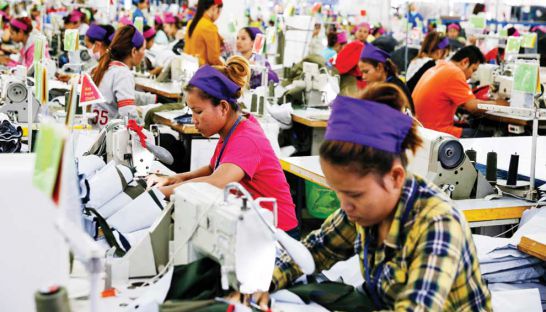Cambodia: Productivity cuts into growth
Cambodia’s GDP growth fell below the 7 percent mark for the first time since 2011 last year, signalling a need for the government to address the country’s low productivity and insufficient public infrastructure spending, according to a World Bank report released yesterday.
Economic growth projections for 2016 fell to 6.9 percent, slightly lower than the previous estimate of 7 percent, while growth is expected to slow to 6.7 percent by 2019, the World Bank said in its annual Cambodia Economic Update.
“Improving labour productivity, as well as the performance of the public sector, will be fundamental for Cambodia if it is to remain competitive, given rising competition from other low-wage garment exporting countries,” the report said.
Concerns over productivity are tied to rising wages in Cambodia, with the report indicating that improvements in labour productivity must match rapidly rising private sector wages in order for the economy to remain competitive.
The minimum wage for garment sector workers rose to $153 per month last year, compared to just $50 in 2007, while the Cambodian government has announced plans to raise the minimum wage for civil servants to around $250 by 2018.
Overall the report noted that productivity growth between 2007 and 2014 remained healthy. Nonetheless, improving the quality of basic education and technical skills, as well as increasing vocational training, need to be priorities for the government, especially as the Kingdom moves toward higher value-added manufacturing.
“While the garment and footwear sector continued to be main driver of growth, the sector’s annual average productivity growth was only a modest 0.16 percent,” the report said. It added that of Cambodia’s overall 6 percent productivity growth between 2007 and 2014, the construction sector saw the fastest growth at an annual average of 2.7 percent, followed by the agriculture sector with 1.8 percent.
Public spending in infrastructure is another area of concern, according to World Bank, which said an overall decrease in partner-funded projects has led to a shortfall in infrastructure funding. It urged the government to allocate more funding to large-scale infrastructure projects while increasing spending efficiency.
“In the context of a declining development partner-funded capital budget, Cambodia will need to enhance public investment management to scale up government financed capital spending,” it said.
“Although rising collection has allowed an expansion of public sector wages, the steady decline of capital spending in recent years does not bode well from improving competitiveness and sustaining high levels of economic growth.”
The overall economic outlook remains positive in the medium term according to the report, with significant growth in the agriculture sector for the first time since 2013 offsetting slower growth in garments exports by value, down to 8.4 percent compared to 12.3 percent in 2015.
Miguel Eduardo Sanchez, senior country economist for the World Bank in Cambodia, said the Kingdom was showing positive signs of economic diversification. He added that the country also faced external downside risks from continued US interest rate hikes, a slowdown in European economies and uncertainties related to global trade.
“Some good news in the industry and manufacturing sectors is that you have all the manufacturing activity outside garments contributing more to GDP,” he said. “This basically signals the beginning of economic diversification in Cambodia.”
Gains from agriculture signalled much needed growth in the industry, though increased yields were hamstrung by lower global commodity prices, Sanchez explained.
“In the agricultural sector, this year we have seen a significant improvement and expansion in production compared to two relatively bad years in 2014 and 2015 due to weather conditions,” he said.
“Nonetheless, despite the increasing growth in yields and cultivated areas, international commodity prices are still down so that means the contribution of agriculture, despite improvements in production, is still a modest contribution to GDP.”
Mey Kalyan, senior adviser to the Supreme National Economic Council, said yesterday that he has seen strong government action to resolve issues of competitiveness, such as infrastructure and human resources. He added that although some have called in the past for Cambodia to move away from the garments industry, he believes the strong base of the sector in the country can help direct the economy towards more value-added manufacturing.
“We would like to use the garments industry as a springboard to other industries,” he said. “It has been vital for economic growth so far. If you compare the garments industry to having a water tank, you will not stop using that water tank unless you know that another tank is available.”
Source: http://www.phnompenhpost.com/business/productivity-cuts-growth


 Thailand
Thailand




